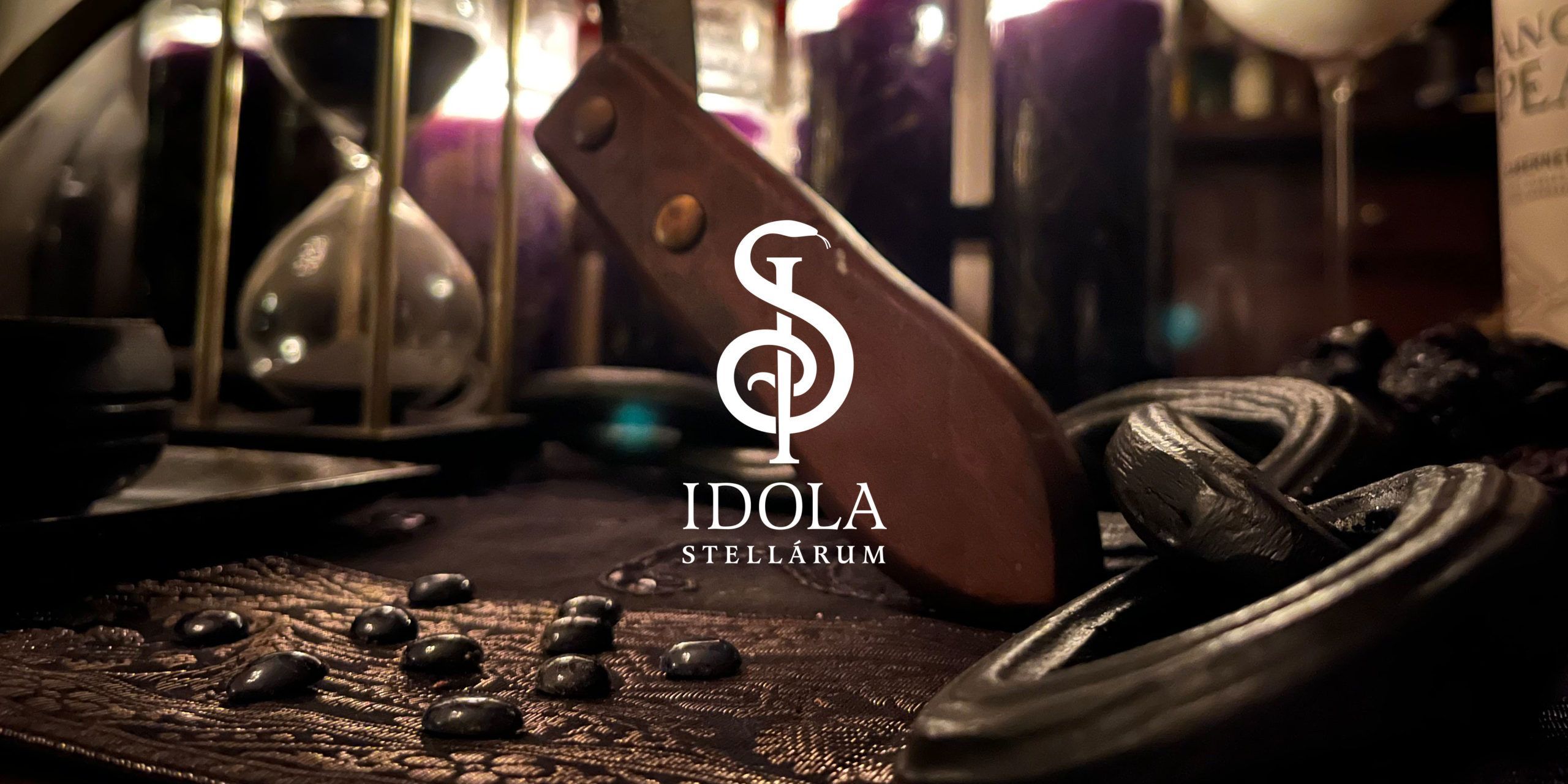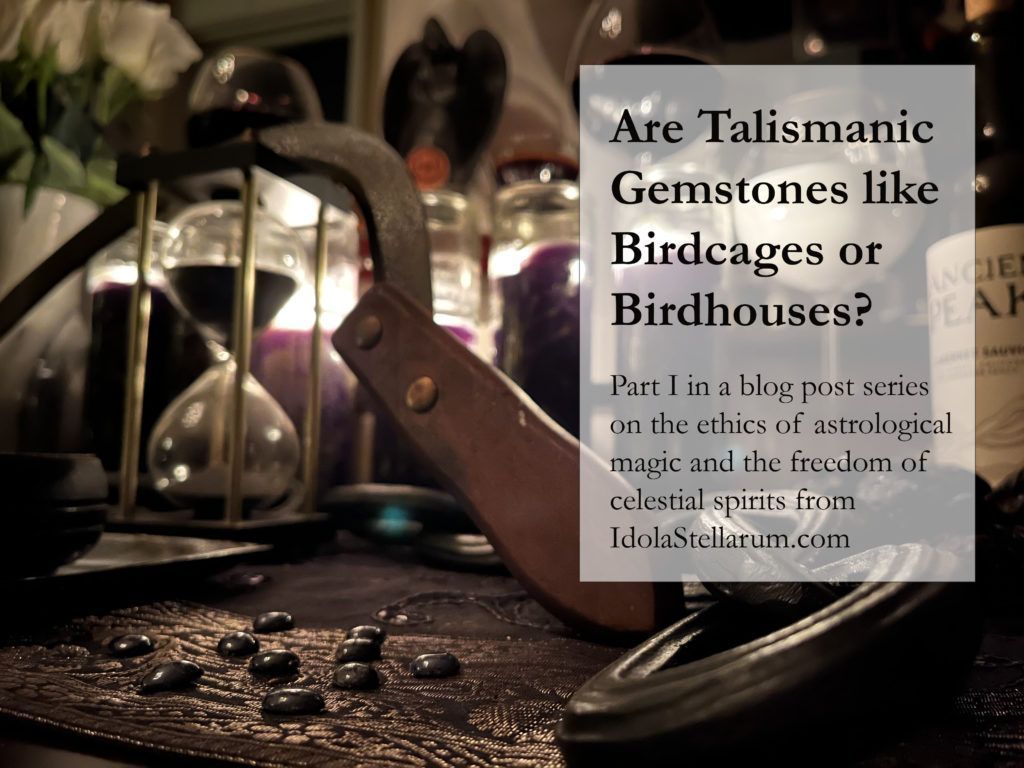Your cart is currently empty!

Talismanic Gemstones are not like Birdcages: On the Essential Freedom of Celestial Spirits (Part I)
When those who are less familiar with astrological magic discover astrological talismans, a natural and understandable question arises: if making astrological talismans brings down a spirit of the stars inside of a gemstone (or metal), does the spirit freely reside there or has it been trapped there?
This question could really worry us. We could begin to imagine some poor spirit who might rather be anywhere else imprisoned within a little stone on our finger or hanging from our neck, unhappily doing our bidding while its friends roam free in the heavens above. Given these concerns, we might further ask: if a talisman is like a birdcage, is it ethical to possess, let alone to make, astrological talismans?
To begin answering these questions, we will draw on textual sources within the tradition, as well as comparing the methods of our tradition of astrological magic to other forms of ceremonial magic—Solomonic magic, in particular. By thinking critically about the source texts in a comparative perspective in Part I of this series, we can dispense with the concern that talismanic spirits get trapped in gemstones or metal like a bird in a birdcage.
In Part II, we will suggest that the metaphor of a birdhouse serves as a better fit than that of a birdcage. In Part III, we’ll consider a more integrated perspective that moves away from potential implicit materialistic assumptions about talismans.
Different Models of Understanding Astrological Talismans
Worries about the freedom and imprisonment of spirits do not make sense within all worldviews or models of astrological magic (for more on the worldviews of astrological magic, we encourage you to check out Christopher Warnock’s FAQ). For some traditional authors, most notably Albertus Magnus and Marsilio Ficino, questions about the freedom of spirits would not arise. These natural magicians did not endorse a spirit model for talismans. They saw talismanic magic as arising from the natural and unimpeded operation of celestial rays, augmented by high quality materials and opportune astrological timing. Ficino wrote:
“[J]ust as a given thing is fortunately born and coalesces and is preserved not elsewhere than here nor at any other time but just then, so also such or such a material action, motion, or event does not obtain full or perfect efficacy except when the celestial harmony conduces to it from all sides. This harmony is thought to have such a great power that it oftentimes bestows a wonderful power not only on the works of farmers and on artificial things composed by doctors from herbs and spices, but even on images which are made out of metals and stones by astrologers.”
—Marsilio Ficino, Three Books on Life, Book III, Ch. XII
For Ficino, there would have been no question about whether it was ethical to use astrological talismans. For natural magicians, talismans were no more unnatural or unethical than planting a seed at the right time, or a doctor applying one specific herb rather than another to a patient. They saw all actions, properly prepared and performed with care, as participating to a greater or lesser degree in an essentially inviolate cosmic harmony. Within this worldview, the astrological magician does not trap living beings, but magnifies pre-existing natural virtues.
The medieval and Renaissance source texts known as De Quindecim Stellis (Hermes on the Fixed Stars) illustrate this perspective. One version states that when a gem is polished and engraved when the Moon joins a given fixed star, “[the gemstone’s] power will be increased a hundredfold” (Quadripertitus, Part II, tr. Regulus Hess). Within a natural magic perspective of understanding talismans, it would be the gemstone’s power, not a spirit’s, that became magnified through the natural activity of celestial rays.
Within a spirit model, however, we need to account for how we understand and interact with spirits. Fundamentally, the broader tradition of astrological magic developed within a framework that understands our place in the universe as a single link in a great and orderly chain of being. Appealing to and conversing with celestial beings was done with deference, respect, and harmonious participation within the cosmic order. This perspective can be seen in the Picatrix, which emphasizes the role of devotion and faith in astrological magic. The following quotation clarifies that astrological magicians perform their work alongside celestial spirits with their own agency who cooperate with the magician:
“[T]his work is not done in order to test or prove whether [the principles and workings of astrological magic] be true or not; rather, they should have faith in their mind that it be true. By this the rational spirit is strengthened, and joined to that virtue of the upper world from which proceeds the celestial spirit that acts in the image; and in this way, what is desired will come to pass. Thus it is is necessary to believe firmly, because it is by this that the image will have the power to call upon the cooperation of the intelligence.”
—Picatrix, Book I, Ch. 4, emphasis added
But by far the clearest position statement we have regarding the birdcage question comes from the Renaissance magician Heinrich Cornelius Agrippa, who wrote the following in a chapter on how “we can draw the divine world and their ministering [spirits]”:
“Thus we read that ancient priests made statues and images that predicted the future and infused them with the spirits of the stars. These spirits were not confined in such material but were happy there; they found that material agreeable to them, always and willingly inhabiting there. While there, they spoke and brought about miracles.”
—Three Books of Occult Philosophy, Book I, Ch. 39, tr. Eric Purdue, emphasis added
Our experience bears this out: although each talismanic spirit has their own nature and (what we might think of as) personality, we have found them on the whole to embody a deep joy akin to a resounding song of praise for the cosmos in consistent cooperation with the prayers and petitions made in the moments of their creation.
Methods of Astrological Magic in Comparative Perspective
We can also learn something about the freedom of the spirits involved in astrological talismans by contrasting astrological magic with other traditions of grimoire magic. In the tradition of Solomonic magic, for example, anyone can with little effort readily understand that the activities of binding, interrogating, and subjugating spirits form the historical core of the methodology. Although some modern ceremonial magicians may employ methods of devotion and supplication of grimoire spirits, these more relational practices clearly stand as the exceptions that prove the rule.
Dr. Stephen Skinner and David Rankine, in the introduction to The Goetia of Dr. Rudd, speak of the tradition of “binding” demons, the practice of “using angels to control demons” (p. 24), and the skills of “interrogating them, imprisoning them, and finally forcing them to obey” (p. 22). Through these methods, the demon or spirit “should be constricted to” a crystal or other location (p. 92), so that the magician can go about “binding…the spirit with an oath” (p. 93) before eventually giving the spirit “license” or “permission” to depart (p. 94). Within the tradition of Solomonic magic, the imprisonment of a spirit is not a concern to be addressed: rather, it is the express and explicit intent of the magical practice.
By contrast, the methods of astrological magicians are at worst neutral with respect to the spirit, and often based on prayers and petitions rather than coercion. By “neutral” we have in mind the practices of Albertus Magnus, who considered inscribing an image in a jewel at the appropriate time to be all that was necessary in order to empower a talisman—no elaborate rituals necessary. An example of a more devotional perspective can be found in the Liber Thebit version of De Quindecim Stellis, which instructs the magician to pronounce the following orison or prayer while creating an astrological talisman:
“O most high Creator of all, Alpha and Omega, who didst make heaven and earth, the sea and all things that are in them: thou hast vouchsafed to all these the virtue wherein it shall be that, by thy Son, thou hast reconciled the lowest with the highest. Now therefore, most merciful Father, do thou in potency conjoin and coadunate [i.e. unite] what is above with what is below, and what is below with what is above, so that the virtue of both may be present in this ring as I implore. Amen.”
—Thabit ibn Qurra, De Quindecim Stellis, tr. Regulus Hess
In this prayer we can see that the work of astrological magic is a participatory rite in which the magician requests (“implore[s]”) the aid of the cosmic hierarchy to unite (“coadunate”) the celestial realm with the sublunary realm. This is a work of harmony, not violation. There is no trace of subjugation or domination. Likewise, in our ceremonies at Idola Stellarum, our talismans are made with the utmost respect and devotion, requesting with humility and in veneration the willing participation of the celestial hierarchy.
We draw these comparisons not to criticize or pass judgment on Solomonic magic or its practitioners, of course: Solomonic magic works within a different tradition, with a different order of spirits, and with different aims and goals in mind. Rather, we bring up the comparison to demonstrate through clear contrast how the methods of astrological magic by their very nature put to rest any worries about the ethics of the care of spirits.
Furthermore, in our understanding of the tradition, the spirits involved in astrological magic are angelic in nature. They participate willingly and joyously in creation, they do not go against their nature, and there is no reason to go about (and arguably no possibility of) compelling them to do one’s bidding in the first place.
Given the inviting, participatory nature of talismanic astrological magic and the nature of the spirits involved, we can dispense with the fear that astrological talismans serve as a kind of birdcage to trap unwitting or unwilling spirits to do our bidding. Although we cannot speak for all practicing astrological magicians, we can state with confidence that every Idola Stellarum talisman has been made with the utmost respect and consideration of the freedom and agency of celestial spirits. An ethic of collaboration, stewardship, and invitation permeates our workings, both magical and mundane.
In future posts, we will expand upon these considerations to offer a different way of thinking about astrological talismans to replace the birdcage metaphor, and challenge any materialistic assumptions of talismans through an elaboration of an integrated spirit model.
Read Part II of this post series: Talismanic Gemstones are more like Birdhouses than Birdcages.
As stewards of the tradition of astrological magic, it is our privilege to bring the wonder of astrological talismans to others. Sign up to our mailing list for word of our upcoming talismanic collections and workings:
By clicking ‘subscribe’, I consent to Idola Stellarum storing my email and information solely for the purpose of communicating upcoming offerings and content, and I am able to unsubscribe at anytime.

